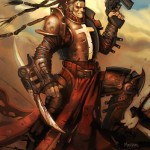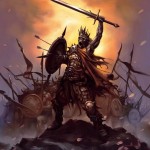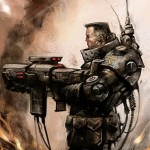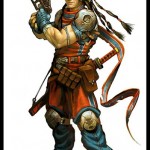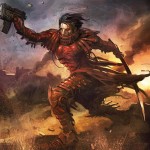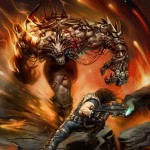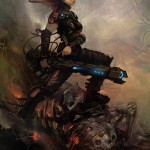Daryl Mandryk
From The CG Channel Interview Archive
Early in his professional career, armed with a business degree, a business suit and a tie, he felt something was missing from his life. Went back to school to study computer animation.
Over the past few years, it seems many digital artists are turning away from the technical, polygon pushing process that is 3D and migrating towards a more creative, liberating 2D approach. Are we going back to the essence of creativity? In this interview, Daryl Mandryk shares his own experience.
Do you remember the very first computer game that really got you addicted?
As a kid I got addicted to pretty much every game I owned, it was out of control. Probably the first game the got me seriously addicted to the point where I spent all my time playing it was Pool of Radiance. This was the old ‘gold box’ version from SSI (Strategic Simulation Inc.). In junior high I was into Dungeons & Dragons, so this game was like a god-send. I remember spending all summer sitting in my basement trying to finish it. Because my computer was so slow, battles could take as long as an hour depending on the number of monsters you were fighting, it was totally silly – but I relished every moment.
First thing you ever remember drawing?
Tough question…I vaguely remember drawing some kind of explorer character and a pyramid for some kind of class assignment, probably in grade 1 or 2. It’s hard to remember a point where I actually started to draw, it seems like something I’ve just always been doing.
Is there one particular thing that made you chose this type of career?
Hm – desperation? After I graduated university I was pretty aimless. I had graduated with a business degree, and basically felt like I was stuck with a career path I didn’t really want. I knew my real interest in art, but I didn’t know enough then about how to go after it, or how do make a career out of it. After a short stint wearing a suit and tie everyday, which drove me nuts, I made the decision that it was all or nothing – I would go back to school and take computer animation and dedicate myself to producing art. It seemed the only thing I was passionate about, so I decided to go for it. As far as a career choice went, I think it suited me well. I loved traditional art, and I loved computers, so digital art was just a nice synthesis of these two things.
What do you believe you would have done if computers had not existed career-wise?
Probably learnt how to oil paint and just do that instead. Obviously there wouldn’t be a need for video game artists, but perhaps illustrations for literature, or something like that might have been my calling. I think I would’ve ended up as an artist no matter what, and most likely a traditional painter.
Some of your earlier work included a lot of 3D. This is something that has almost disappeared from your latest work. Have you abandoned 3D all together?
I think I just got a bit disillusioned with the whole concept of creating 3D art. At the beginning there was a real rush when you made something in 3D….and you really felt like you were on the cutting edge of art. Because I focused more on modeling and texturing I really didn’t pursue the animation side of it, so essentially I had become a 3D illustrator. This was fine for a while, but at the end of the day I would look at my art and basically rea liz ed I was just doing 3D-character concept art. Which is fine, but the amount of time and effort required is just ridiculous. I would go to bed at night with sore arms and swollen wrists, and it just wasn’t worth it. And I rea liz ed that my growth as an artist was being limited because so much of my time was being spent on technical issues rather than artistry. I also subscribed to the school of thought that your 3D work was only as good as your 2D work and I felt I needed to go back and build a more solid foundation for myself artistically. In some ways I feel that 3D was a shortcut for myself not taking the time to learn traditional methods and the fundamentals, so I felt I needed to right that wrong.
I bought Painter and decided to basically teach myself how to paint digitally, with the goal of making images as visually arresting as a 3D render, but with more personality and life. The cool thing was that my background in 3D really helped me in terms of modeling, texturing, and lighting in 2D. When I paint I almost imagine it as a 3D scene and I am sculpting out geometry and adding texture and lights. The workflow is actually quite similar.
I haven’t abandoned 3D though; I still use it quite often for various things. For example, blocking out perspective and painting over top of it. I also have been using Z-brush, which is an amazing program and hopefully points to what the future might hold for 3D apps.
Do you see a trend where it seems 2D digital work is somehow “Stealing” the spotlight away from 3D in our industry?
That’s interesting. There are defiantly more people doing digital painting now than ever before. I think maybe 3D is becoming so commonplace that it’s getting harder to surprise people with 3D renders. The first time I saw something GI rendered I was floored, but now it’s so commonplace that I think the “wow” factor of looking at something real but unreal has sort of dissipated a bit. what really wows people now is the content and artistry more than the fact that it looks real. And I think, in general, that is harder to accomplish. You can’t just make something photo-real and expect people to be floored by it, you need more. That’s why I think 2D artists have a bit of advantage, because they can work so fast, and try so many variations so quickly, that those things add up, and what you end up with something closer to what the artist originally envisioned, and it’s captured better.
Do you have favorite shades of colors when starting a new project?
Not really. I like to start by blocking in large masses of color and shapes, and I guess I tend to go more towards dark neutral colors for this. Probably because I don’t like to make big decisions right away – I would rather like the painting to develop on it’s own, with ideas working their way in at unexpected times.
Tell us about your creative process, how you go from a blank canvas all the way down to a full-color masterpiece?
The simplest way to explain it is that I start very very simply and slowly refine it until I am happy with the results. It is a bit like building a house. You start with the foundation – very simple forms and colors and go from there.
At the beginning of a painting I am only interested in finding a pleasing composition and blocking out very basic values and colors. I create a very low rez file, and choose a big brush. This is an almost abstract process where you are trying to find your overall balance of the paintings and what the focal point might be. It’s also the most experimental, as most times I only have a vague idea of what I’m trying to paint.
From there I go in and start blocking in the large masses that make up the figures or objects. These are just rough block-ins that have some very basic lighting blocked in. I can easily make changes to the composition at this stage, and I often spend a good amount of time cutting out things, scaling them, and just generally playing around with the image.
Finally, when I happy with things I up-rez and begin detailing. This is where the real sculpting out of forms is done and you go in and add all the little details like clothing/armor and what have you. Now I am trying to balance out specific parts of the image – where as in the earlier steps I was trying to achieve balance with the whole scene. Design becomes important here as I try and make things look functional and cool at the same time. I try and paint from dark to light, and always with my light source in mind. This process can continue however long I need it to. For a print-res image I might repeat this process and up-rez and tighten even more. As a finishing touch I will play the contrast and colors of a scene to try and achieve something really pleasing.
What is your biggest source for inspiration when working on a personal project?
I’m not sure where my inspiration comes from, I think it comes from a lot of places. I might be inspired by a passage in a book I read, or the nightly news, or song I heard. I constantly listen to music while I paint, and that helps me get pumped up and in the mood to create something. The darker and moodier the music, the better.
Professionally, what type of projects do you enjoy working on the most?
Any project that gives me a lot of creative freedom is a great project. Other than that, my favorite genre is sci-fi / fantasy so anything in that area is always fun. I think as a commercial artist you have to be open to any kind of project – simply because that is how you make a living, and you need to be prepared to do anything. It’s you job to make something that may seem boring to you into something cool – that’s what you get paid to do, and it’s a situation I’m sure all artists face.
Any film ambitions?
I think it might a natural avenue to explore in the future, but it’s not something that I stay up at night dreaming about or whatever. I think that the film (as well as the video game industry) is bit over-glamorized, and when it all boils down one job is very similar to another. I think if the right project came along that I was passionate about I would probably be very active in pursuing it.
Where would you like to be 5 years from now?
Good question, I don’t even know what I’m doing this weekend! I guess I might be pursuing a freelance career. I feel like I’m just at the tip of the iceberg in terms of digital painting, so I’m not sure where it will take me.


